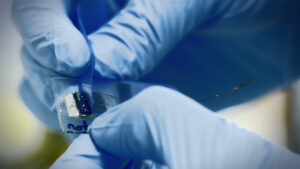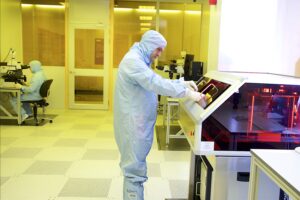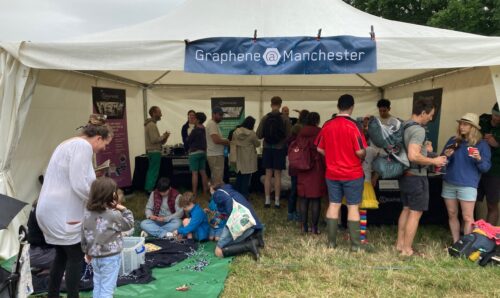How do you keep a cleanroom clean?
Research 15 December 2016
The air inside a cleanroom is one million times purer than the air we breathe each day. The National Graphene Institute (NGI) boasts 1500 square meters of cleanroom space but what is a cleanroom and how do you keep it clean?
Essentially a cleanroom is an environment free of dust and contamination. People working within a cleanroom are required to wear protective clothing to ensure that they do not contaminate any of the devices or samples that they are working on.
Chloe Holroyd, a Cleanroom Technician working in the NGI cleanrooms explains what it takes to keep these state-of-the-art laboratories running.
To give my day-to-day work some context there needs to be some quick introductions to the cleanroom tech team – there’s quite a few of us!
I work most closely with my fellow technicians, James, Matt and Richard. We also work alongside the cleanroom Experimental Officers (EOs), Andrew, Fred, Alexander and Weisheng. Under Fran’s management, between the technicians and EOs we support the research that takes place in the cleanrooms of the National Graphene Institute.

A day in the life of a cleanroom technician is varied and always busy. Each day starts with a daily cleanroom check, where we go round the cleanrooms, monitoring that all of the areas are clean and tidy and that there are consumables available for the researchers.
Once the daily checks are complete the rest of the day really could be anything! It could be writing COSHH forms/risk assessments for chemical processes, ordering/receiving consumables, helping each other with urgent tasks, escorting engineers in and out of the cleanrooms, delivering training on the ellipsometer (ellipsometry is a technique that uses light to measure the thickness and optical properties of a sample), and conducting fume hood/wet bench inductions – anything!
Graphene may be thought of as an atomically thick material, however graphene has numerous forms depending on both the graphene’s thickness and if other atoms are bonded to the graphene.
Furthermore, as the research here in the National Graphene Institute is not limited to graphene but also encompasses other 2D materials, the cleanrooms house numerous instruments catering for all types of sample preparation and characterisation. Therefore as part of keeping the cleanrooms running smoothly, another responsibility of the tech team is to ensure that these complex (and expensive!) instruments are kept fully operational.

As the NGI is still in its infancy, a fairly large proportion of the work done by my colleagues and myself has involved resolving inevitable niggles in the daily running of the cleanrooms, and we’ve also been involved in the commissioning of new processes/protocols.
Most recently, I’ve been heavily involved in developing safe methods for working with hydrofluoric acid (HF); ensuring that the assigned wet bench is HF ready, that the waste will be safely disposed of, and most importantly, ensuring that researchers will be able to do their sample preparation safely.
I believe that in an ideal lab a technician’s work would go unnoticed by the researchers because the work done by technicians enables researchers to do their work unhindered. Now that we’re reaching more of a ‘steady state’, the focus of our work is definitely shifting from reacting to issues that have arisen to preventing, where possible, issues from arising in the first place, with the aim always to try and enable research to continue as problem-free as possible.
I really enjoy working as a cleanroom technician; how varied day-to-day work is, seeing tasks to completion and the team I am part of.
cleanroomsNational Graphene Institutescience





Very interesting. Where is all this leading to career wise ? Is there a pecking order?